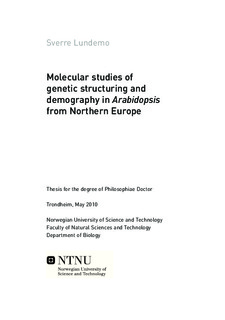| dc.contributor.author | Lundemo, Sverre | nb_NO |
| dc.date.accessioned | 2014-12-19T13:11:38Z | |
| dc.date.available | 2014-12-19T13:11:38Z | |
| dc.date.created | 2010-07-14 | nb_NO |
| dc.date.issued | 2010 | nb_NO |
| dc.identifier | 330028 | nb_NO |
| dc.identifier.isbn | 978-82-471-2152-8 (printed ver.) | nb_NO |
| dc.identifier.isbn | 978-82-471-2153-5 (electronic ver.) | nb_NO |
| dc.identifier.uri | http://hdl.handle.net/11250/244696 | |
| dc.description.abstract | The seed bank is an important part of plant population dynamics, capable of storing genotypes accumulated over several seasons, thereby creating a genetic reservoir which can resupply the above ground population regularly or after disturbance events. Thus, the seed bank can function to increase genetic diversity and effective population size in the population as a whole. Additionally, the seed bank can restore the above ground population if it is reduced or even completely destroyed. Consequently, seed banks may have an impact on both the ecology and evolution of species.
In this thesis, I have mainly investigated effective population size, generation time and geographic patterns of structuring in two closely related crucifers, Arabidopsis thaliana and A. lyrata, especially how this is impacted by the presence of a seed bank. They are both naturally occurring in Norway, inhabiting disturbed habitats with low levels of competition. It has been suggested that the species diverged from each other approximately 5-9 million years ago. Due to the availability of molecular tools for this genus, they are widely used in research focusing on e.g. variation in physiological and morphological traits and how this may affect evolutionary processes such as local adaptations to environmental conditions. Both A. thaliana and A. lyrata harbour seed banks, although the density of seedlings and the impact of this cohort on effective population size (Ne) seem to be different. A. thaliana have a higher seedling density as seen from soil sample germination, and its seed bank cohort contribute more to Ne, compared to in A. lyrata. Both species show a geographically structured pattern throughout the Norwegian distribution range, although differentiation between populations is much higher in A. thaliana. This indicates that populations of A. thaliana are more isolated, and this may be due to differences in mating system and habitat characteristics.
A. thaliana is an annual species, and population dynamics in this species should therefore be more dependent upon the seed bank than in A. lyrata, which is perennial and therefore should exhibit more stable population size and composition. The latter is also capable of vegetative spread by sending out lateral stolons, thus producing new rosettes genetically identical with the mother plant and further reducing the need for high annual seedling recruitment. The amount of clonal genets, as well as the size of these genets, vary within a population, and are more likely related to resource availability than plant density. Clonality is found to cause fine scale genetic structure in a large population of A. lyrata at Spiterstulen, Norway. However, there was no overall population structure, and topographic features believed to constitute barriers for gene flow did not seem to cause genetic substructures. Still, it is not yet clear how seed flow and pollen flow act separately on spatial genetic structure in the population.
Whereas A. lyrata is strictly outcrossing throughout most of its distribution range, A.thaliana is almost exclusively self-pollinating, and plant-pollinator interactions have not been explored thoroughly in this species. It is shown that insect visitation rates in a Central Norwegian population is about ten times higher than a similar study from Germany, but this did apparently not result in outcrossing events during the observation season. However, evaluation of genotypic data from other seasons in this population show that outcrossing events do occur, and this highlights the importance of a more comprehensive sampling regime when trying to describe population genetic structure. | nb_NO |
| dc.language | eng | nb_NO |
| dc.publisher | NTNU | nb_NO |
| dc.relation.ispartofseries | Doktoravhandlinger ved NTNU, 1503-8181; 2010:95 | nb_NO |
| dc.relation.haspart | Lundemo, Sverre; Stenøien, Hans K; Savolainen, Outi. Investigating the effects of topography and clonality on genetic structuring within a large Norwegian population of Arabidopsis lyrata.. Annals of Botany. (ISSN 0305-7364), 2010. <a href='http://dx.doi.org/10.1093/aob/mcq102'>10.1093/aob/mcq102</a>. <a href='http://www.ncbi.nlm.nih.gov/pubmed/20519240'>20519240</a>. | nb_NO |
| dc.relation.haspart | Lundemo, S.. Flower visitation has small effects on outcrossing levels in a natural population of <em>Arabidopsis thaliana</em>. . | nb_NO |
| dc.title | Molecular studies of genetic structuring and demography in Arabidopis from Northern Europe | nb_NO |
| dc.type | Doctoral thesis | nb_NO |
| dc.contributor.department | Norges teknisk-naturvitenskapelige universitet, Fakultet for naturvitenskap og teknologi, Institutt for biologi | nb_NO |
| dc.description.degree | PhD i biologi | nb_NO |
| dc.description.degree | PhD in Biology | en_GB |

